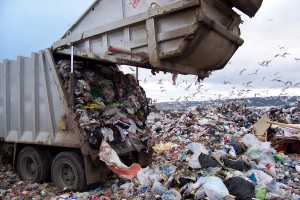
Packer truck dumps garbage at landfill. Is this good to compost?
There are many nuances in the new garbage-to-energy initiatives. In May a conference is coming to San Francisco put on by the new wave of wasting enthusiasts who claim their high-tech schemes are “sustainable.” Last September I went to a bioconversion conference where the enthusiasts claimed the maximum we can recycle is 65% of discards (they dispute today’s higher claims by San Francisco, Berkeley, and other cities). So that makes it okay to mash the remainder together and put it into a digester. The processes generate methane, which can be burned for energy. They call it “sustainable” energy and the digestate can be landfilled.
Some of my questions are: doesn’t this put a lid on recycling? Doesn’t this set of technologies require 20-30-year put-or-pay contracts for the discard supply? Doesn’t it require 20-30-year contracts for the methane or electricity demand? Doesn’t it require community assistance in siting and overcoming local resistance? Doesn’t it assume high-nitrogen feedstock, which would discourage clean composting of yard debris and food? If it receives MSW, doesn’t it mix in toxics from under the kitchen sink? What’s the chemical composition of the digestate if the feedstock is MSW? The products must be as variable as the MSW batches.
One speaker last September was from Germany. He said there are many digestion plants around Germany. He was the only speaker, however, who accepted only clean yard debris and food. He said his digestate could be used as soil amendment. He wouldn’t give me an opinion about composting MSW; he only talked about his own operation.
Dan Knapp went to a BioCycle conference in Wisconsin in November that featured digestion of clean manures from dairies. Those operations looked very interesting and indeed sustainable.
Garbage in, garbage out.

